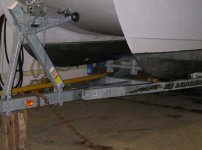John S
Member
- Joined
- Jul 5, 2006
- Messages
- 286
- Reaction score
- 0
- C Dory Year
- 2021
- C Dory Model
- 255 Tomcat
- Vessel Name
- TomCat
Looking for some Tomcat help/advice.
My sea water intake for my toilet and washdown is located on my inner starboard pontoon VERY far forward. All is great until we get underway and up on step. Then the intake is no longer in the water and I can't use the washdown pump to clean up or clean fish.
So..........
Were all TC24's built using this same postion or were later models located somewhere more useful?
Where is the intake for the TC25 located?
Anyone else have this problem on the TC and come up with a solution??
Sure appreciate any thoughts or comments. Here's a couple photos to show my intakes postion.


Thanks
My sea water intake for my toilet and washdown is located on my inner starboard pontoon VERY far forward. All is great until we get underway and up on step. Then the intake is no longer in the water and I can't use the washdown pump to clean up or clean fish.
So..........
Were all TC24's built using this same postion or were later models located somewhere more useful?
Where is the intake for the TC25 located?
Anyone else have this problem on the TC and come up with a solution??
Sure appreciate any thoughts or comments. Here's a couple photos to show my intakes postion.


Thanks
